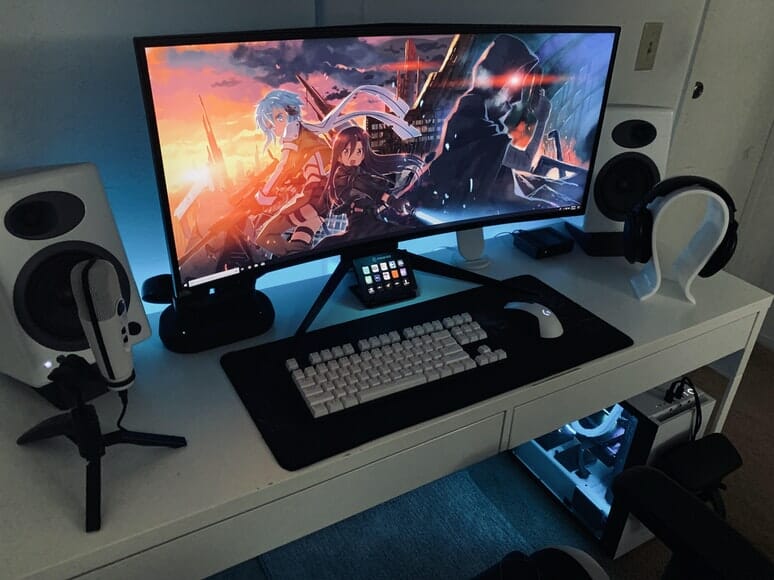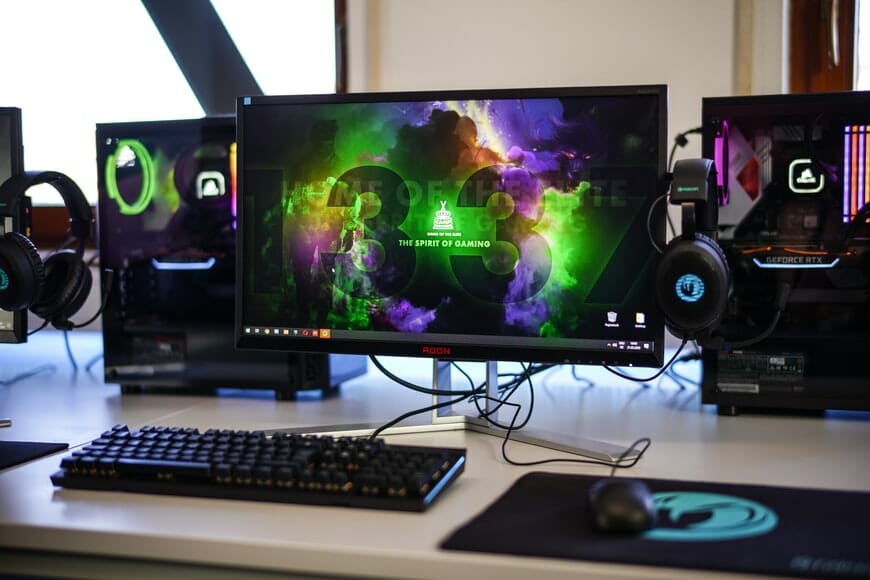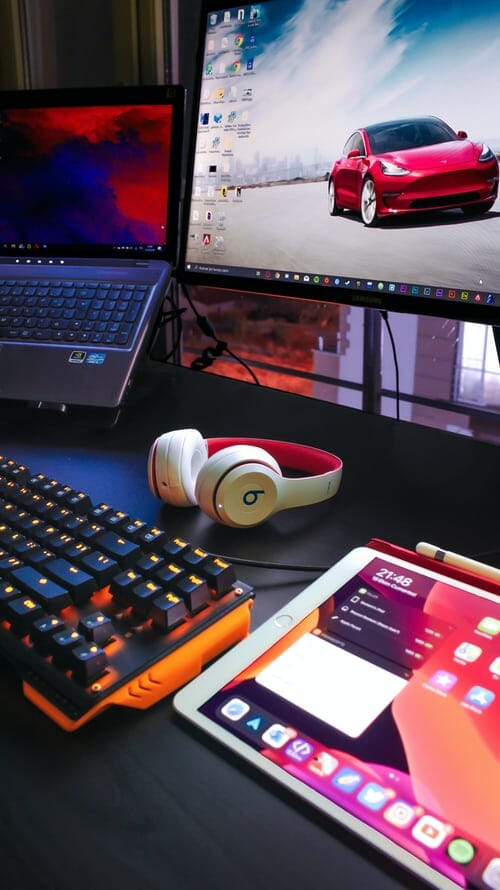Table of Contents
What do you need to consider when choosing a PC gaming monitor? Some gamers might immediately say "resolution and refresh rate," but there's more to it than that. You'll want to look for a display that has an acceptable resolution - from 1920x1080 up to "4k" at 3840x2160, or even "5k." It's important to consider the type of graphics card you have before making this decision.
Most graphics cards can handle an acceptable resolution of 1920x1080, but today's cards are designed for gaming performance at higher resolutions - up to 4k or even 5k. Higher resolutions mean more pixels moving around the screen every second. So be sure your computer is capable of handling a higher resolution, or you might experience stuttering or worse - no picture at all.

What Is 4K?
4k is a standard resolution with a vertical resolution of at least 3840 pixels and a horizontal resolution of at least 2160 pixels. It gives you about 8.3 million pixels on the screen, compared to "1080p HD," around two million pixels.
What Is 144hz?
Like the Asus rog swift monitors, today's gaming monitors run at a refresh rate of 60hz, which means the screen refreshes itself 60 times per second. That generally works fine for most games unless you're playing extremely fast-paced first-person shooters where the slightest lag could spell doom for you and your team. 144hz monitors can display up to 144 frames per second and have been the standard for most competitive gamers. However, it's possible to achieve similar results with a 60hz monitor by cranking up in-game settings.
What’s the Refresh Rate?
The refresh rate is the number of times your monitor updates the image it's displaying per second. It's measured in Hertz (Hz). For modern displays, refresh rates are at 60, 120, or 144hz, indicating their cycles per second.
V Sync, G Sync, and FreeSync
It's worth noting that specific 4k 144hz monitors might have unique features that increase performance. For example, some of them can enable V-sync or G-sync to cut down on lag time and increase response rates for a smoother gaming session.
In addition to looking at a display's refresh rate, you need to consider whether or not it supports V-sync and G-sync. These technologies allow for variable refresh rates, which means that they can adapt to the frame rate of a video game instead of using a standard 60hz, 30hz, and so on. This results in fewer image processing issues and less input lag time.
What Is a Gaming Monitor?
A gaming monitor is a display designed with gamers in mind. They generally have higher refresh rates and a slower response time. Response time is the time it takes for a pixel to change from one color to another. It's important because many gamers often need fast screens with quick refresh rates to make accurate movements.

Do I Need a Gaming Monitor?
Even if you aren't a gamer, you may want to consider a gaming monitor such as the Asus rog swift. These displays offer higher refresh rates and usually come with additional features such as USB hubs, speakers, and ergonomic stands.
What Resolution and Refresh Rate Should I Look For?
It's really up to you and your budget. 4k screen sizes are less expensive than ever before, though they tend to come with a higher price tag. If you can, try to test one out at your local electronics store before purchasing it online.
It's also important to note that buying an older model will usually save you money yet still offer the same level of quality as the latest models. Older 4k screen sizes tend to come with lower refresh rates.
4k vs. 144hz For General Use
Both of these technologies offer their unique benefits, but if you're planning on using your monitor for general use as well as gaming, a 1080p display with a 144hz refresh rate would probably be your best bet. For the most part, it's unlikely that you'll use more than one or two of these features at any given time.
If you play games while checking email, browsing online, and editing photos on the side, you might not even need a monitor with a high refresh rate. The main benefit of 4k displays is that they offer much more detail than 1080p screens, so it might be worth considering for anyone who works with graphics or videos daily.

However, 1440p is quickly becoming the industry standard for monitors since they can handle high frame rates while also offering similar levels of detail as 4k displays. For this reason, the choice between them comes down to your personal preferences and needs.
Which One Gives the Best Image Quality?
The main benefit of 4K displays is their high detail level. They can display much more information than 1080p screens, which results in sharper images and video.
For anyone who deals with graphics or work that requires a lot of video editing, 4K would likely be best for them since it offers such a clear view.
Of course, 4K and 1440p displays (and monitors that offer a combination of both) tend to come at a fairly steep price. If you can get one with 144hz refresh rates for under $500, it's probably worth buying, but if not, then your best bet would be getting a monitor with 60hz - see also best 1440p 240Hz monitors.
What About Refresh Rate?
Refresh rate essentially acts as a multiplier for how many frames per second you're able to view on your monitor. For this reason, a 144hz display is much better at handling games that demand a lot of processing power.
For example, if you have a 60hz monitor and are playing a fast-paced game that's demanding on your graphics card, then the monitor might only refresh at 30 or even ten frames per second.
It can result in lag time and choppy graphics.
Since 144hz displays can handle these types of games without much trouble, it might be worth paying extra for one if you play very demanding titles often. Most games can't take full advantage of this feature, though. And even though 144hz displays are great for dealing with fast-paced action in video games, you'll likely find that the difference between 60 and 144 is minimal when playing most titles.
It's because most games aren't built to run at a very high frame rate. Don't get us wrong; they're certainly better than 60hz displays when it comes to holding steady frame rates.
4k vs. 144hz Monitors: Which Is Better?
Both of these technologies will offer you an amazing viewing experience, even if it isn't for the same reasons. The main difference is that 4k offers more detail than standard 1080p, while 144hz monitors can handle playing games at ultra-fast frame rates. For this reason, choosing between them comes down to your needs and personal preference.
Do you play very fast-paced games at the highest possible settings? If so, then a 4k 144hz monitor is probably your best choice.
On the other hand, if you prefer more detail in your image while playing games with less demanding graphics, 4K might be for you. But it is essential to note that not all 4K displays can handle 144hz.
It's also important to note that if you decide to go with a 1440p monitor, it's possible to find ones that can reach refresh rates of up to 165hz (although these are rare). Even though the difference between 60 and 165 is relatively small, it's still an improvement over 1080p.

FAQ
Q. Can 4K have 144Hz?
A. Yes, 4K can have 144Hz. However, most devices with 4K native resolution do not have a high refresh rate. The main reason for this is that currently, 1440p displays can hit the highest refresh rates on the market today and the same level of detail as some 4K monitors.
Q. Is a higher refresh rate better?
A. A higher refresh rate is better, and it's recommended for gamers. If you're playing a game with many fast-paced movements, having a high refresh rate will prevent motion blur. The motion will appear much smoother since the pixels can quickly change colors to keep up with your movements.
Q. Is 4K or 144Hz better?
A. A 4K monitor may not run at 144hz, and a 144hz monitor might not handle the larger 4K resolution. If you're looking for 4K and high refresh rates, it's best to find something with 1440p resolution instead.
Q. Is 4K 60Hz better than 144Hz?
A. No, 4K at 60Hz will be much worse than a 1440p 144Hz monitor. A 1440p monitor running at 144hz is the highest quality you will get for any gaming without resorting to something like Virtual reality.
Q. Is 4K or 120hz better?
A. Both 4K and 120hz are great for gaming. The difference between the two is that 4K has a higher resolution than 120hz, meaning it will provide a clearer picture of what is happening on the screen. However, with 4k, you will need to have an extremely powerful computer to run the game smoothly. On the other hand, 120hz provides smoother gameplay because of its high refresh rate, which eliminates motion blur from fast-moving objects in games.
Conclusion
Both 4K and 144hz are great technologies, but if you're looking for the best monitor in terms of overall quality, your best bet might be somewhere around 1440p or 144hz. Of course, this is assuming that you don't spend most of your time gaming.
If you play video games often and tend to play demanding titles, it might be worth getting a monitor with 144hz. It's especially true if you have a CPU that can handle these types of games without too many hiccups since it'll be able to keep up with the higher refresh rate.

